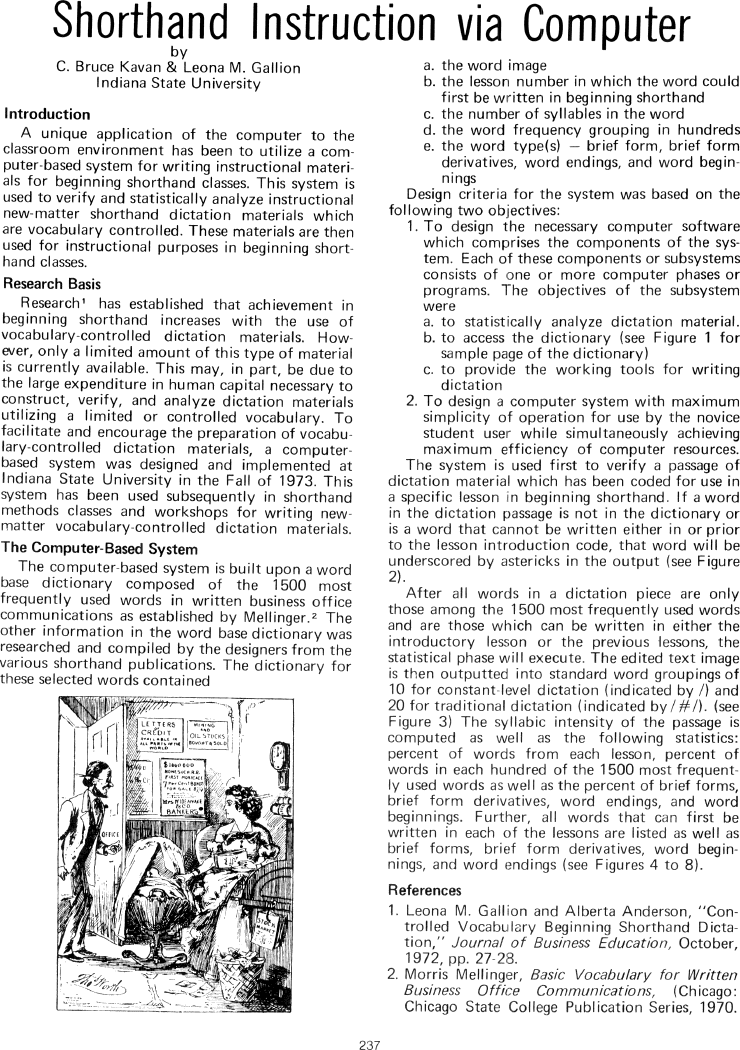The Best of Creative Computing Volume 1 (published 1976)
Shorthand Instruction via Computer (writing instructional materials for shorthand classes, verify and statistically analyze new-matter shorthand dictation)

Shorthand Instruction via Computer
by C. Bruce Kavan & Leona M. Gallion
Indiana State University
Introduction
A unique application of the computer to the classroom environment has been to
utilize a computer-based system for writing instructional materials for
beginning shorthand classes. This system is used to verify and statistically
analyze instructional new-matter shorthand dictation materials which are
vocabulary controlled. These materials are then used for instructional purposes
in beginning shorthand classes.
Research Basis
Research1 has established that achievement in beginning shorthand increases with
the use of vocabulary-controlled dictation materials. However, only a limited
amount of this type of material is currently available. This may, in part, be
due to the large expenditure in human capital necessary to construct, verify,
and analyze dictation materials utilizing a limited or controlled vocabulary. To
facilitate and encourage the preparation of vocabulary-controlled dictation
materials, a computer-based system was designed and implemented at Indiana State
University in the Fall of 1973. This system has been used subsequently in
shorthand methods classes and workshops for writing new-matter
vocabulary-controlled dictation materials.
The Computer-Based System
The computer-based system is built upon a word base dictionary composed of the
1500 most frequently used words in written business office communications as
established by Mellinger.2 The other information in the word base dictionary was
researched and compiled by the designers from the various shorthand
publications. The dictionary for these selected words contained
[image]
a. the word image
b. the lesson number in which the word could first be written in beginning
shorthand
c. the number of syllables in the word
d. the word frequency grouping in hundreds
e. the word type(s) - brief form, brief form derivatives, word endings, and word
beginnings
Design criteria for the system was based on the following two objectives:
1. To design the necessary computer software which comprises the components of
the system. Each of these components or subsystems consists of one or more
computer phases or programs. The objectives of the subsystem were
a. to statistically analyze dictation material.
b. to access the dictionary (see Figure 1 for sample page of the dictionary)
c. to provide the working tools for writing dictation
2. To design a computer system with maximum simplicity of operation for use by
the novice student user while simultaneously achieving maximum efficiency of
computer resources.
The system is used first to verify a passage of dictation material which has
been coded for use in a specific lesson in beginning shorthand. If a word in the
dictation passage is not in the dictionary or is a word that cannot be written
either in or prior to the lesson introduction code, that word will be
underscored by astericks in the output (see Figure 2).
After all words in a dictation piece are only those among the 1500 most
frequently used words and are those which can be written in either the
introductory lesson or the previous lessons, the statistical phase will execute.
The edited text image is then outputted into standard word groupings of 10 for
constant-level dictation (indicated by /) and 20 for traditional dictation
(indicated by /#/). (see Figure 3) The syllabic intensity of the passage is
computed as well as the following statistics: percent of words from each lesson,
percent of words in each hundred of the 1500 most frequently used words as well
as the percent of brief forms, brief form derivatives, word endings, and word
beginnings. Further, all words that can first be written in each of the lessons
are listed as well as brief forms, brief form derivatives, word beginnings, and
word endings (see Figures 4 to 8).
References
1. Leona M. Gallion and Alberta Anderson, "Controlled Vocabulary Beginning
Shorthand Dictation," Journal of Business Education, October, 1972, pp. 27-28.
2. Morris Mellinger, Basic Vocabulary for Written Business Office
Communications, (Chicago: Chicago State College Publication Series, 1970.


